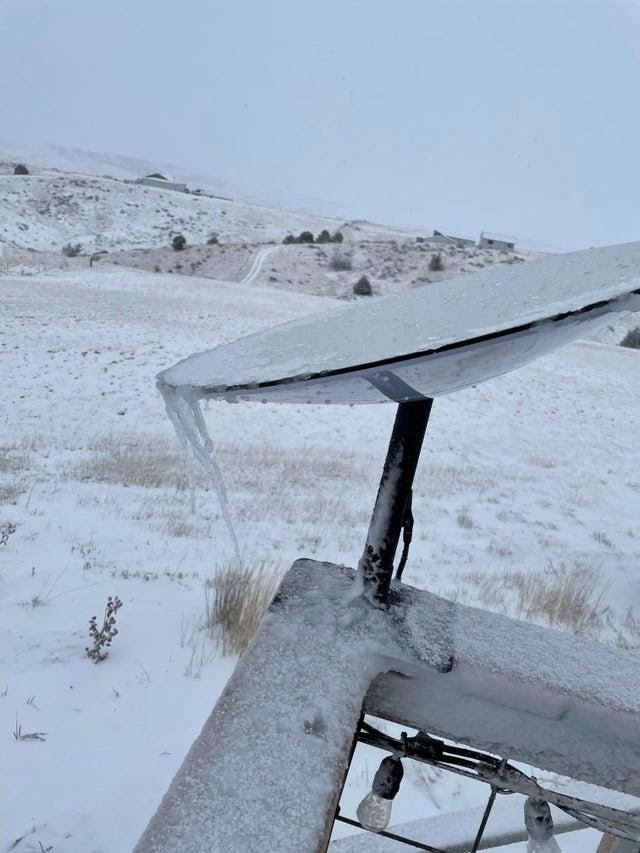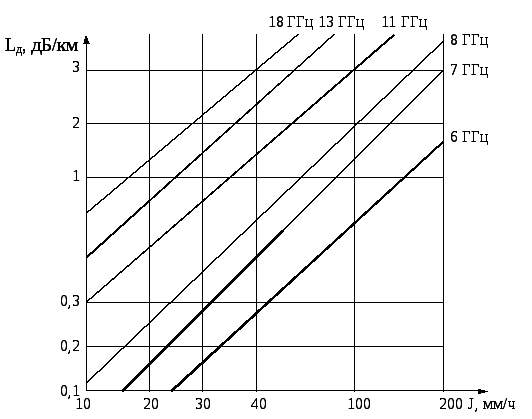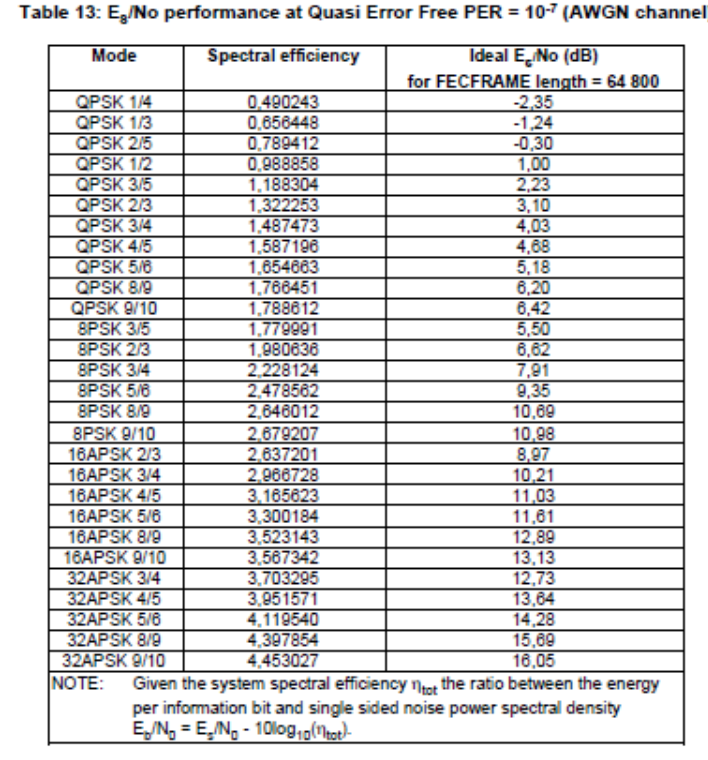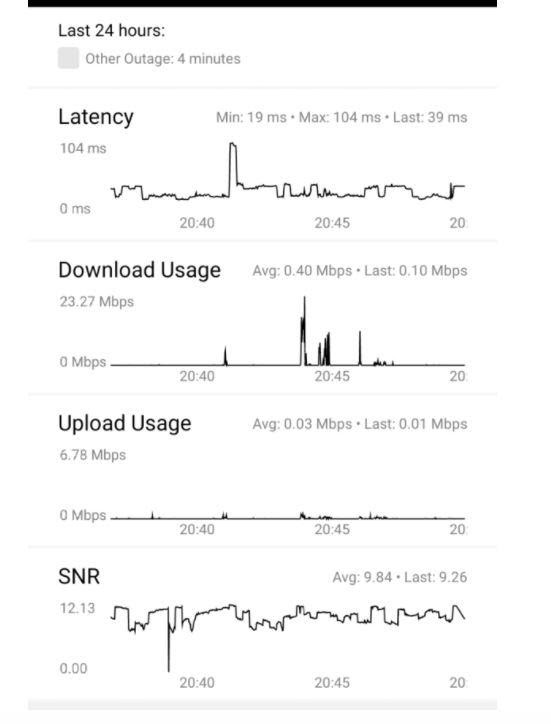Starlink and weather
After public beta testing began and hundreds of enthusiasts received, assembled and connected their terminals to the network, "folk" experiments began, leading the "experimenters" to interesting and sometimes even correct conclusions.
First of all, everyone was interested in the influence of the weather, and given the season (deep autumn) and the geographical location (north of the United States in the region of 50 parallels), the main disputes were about whether snow and rain affect the work and data transfer rate.

Let's start with a theory that tells us that any medium will attenuate the radio signal. This is detailed in the Methodologies of the International Telecommunication Union (for the curious it is here https://www.itu.int/dms_pubrec/itu-r/rec/p/R-REC-P.619-3-201712-S!!PDF- R.pdf ).
Briefly, it is established that for radio waves with a frequency of more than 500 MHz, the main attenuation is determined by tropospheric gases, oxygen and water vapor, as well as rain and other hydrometeors, while carbon dioxide (CO2) and nitrogen, oddly enough, have an extremely weak effect ... In this case, the dependence of the attenuation of the radio wave also depends on the frequency and has peaks, for example, at 22 and 60 GHz.
Given that the composition of the atmosphere is stable, only precipitation can affect the operation of Starlink. It was found that precipitation for signals of different frequencies affects differently, and this influence is associated with the dependence of the wavelength and the size of the raindrop. Radio wave length = speed of light / frequency
| Frequency, GHz | 4 | 6 | eleven | fourteen | 18 | thirty |
| Wavelength, cm | 7.5 | 5.0 | 2.7 | 2.1 | 1.7 | 1.0 |
Hydrometeors in the troposphere (drops of rain and fog, snow, etc.) scatter the energy of radio waves, the wavelength of which is commensurate with the size of hydrometeors. Let us show the attenuation of the signal in rain L d at different elevation angles α and the probability of rain falling ( T d ) (Figure 2.7).

Fig. 1. Frequency dependences of signal absorption in rain on frequency at different elevation angles and probability of rainfall
Attenuation in rain in dB per 1 km with vertical polarization and 18 º , depending on rain intensity, J mm / h is shown in Fig. 2

Fig. 2. Attenuation of the signal depending on the intensity of rain J for different frequencies
If we go into a practical plane, the lower the frequency of the satellite signal, the less it is affected by rain and other precipitation. Therefore, in those regions where heavy showers or precipitation is possible (usually subtropics and the equatorial zone), a lot of stations operate in the C band, that is, 4/6 GHz.
My practical experience in Russia with satellite terminals of the Ku (11/14 GHz) and Ka (18/30 GHz) bands suggests that the influence of precipitation on their work is certainly there, but it should not be exaggerated. Usually, the loss of communication in the Moscow region occurs during the passage of a thunderstorm front and lasts 10-15 minutes. Owners of satellite TV (NTV Plus or Tricolor) see how the picture "crumbles into squares".
At the same time, snow and ice have a low dielectric constant (unlike water, the difference is up to 25 times) and practically do not interfere with signal reception and transmission. The most problematic from the point of view of the influence on the transmission of a radio signal is water, with its abnormally high dielectric constant (it is equal to 81, despite the fact that for most other materials it is less than 10). And a layer of 1-2 mm of water on the signal receiver or transmitter (and not on the mirror itself !!!) is enough to significantly impair the signal transmission). True, in the case of the Starlink terminal, the transmitter / receiver chips are located immediately below the antenna surface, but due to the tilt of the terminal during operation and possibly a special coating, water quickly drains from it
However, even heavy rains and melting snow, as established by the owners of Starlink terminals, still practically do not affect its speed. Why??
First of all, let us indicate which parameter characterizes the influence of the atmosphere on the operation of the terminal. Starlink calls it SNR (Signal-noise ratio), and in the literature it is usually written as Eb / No (with a corresponding interesting Russian version of "ebinoise"), which is measured in decibels and is usually in the range of 3..20 dB. In accordance with the available power reserve, we can use various signal modulations from BPSK to 64QAM, which allow us to obtain a spectral efficiency from 0.5 to 6 bits / Hertz, that is, to obtain a transmission rate from 1 MHz from 500 kbit to 6 Mbps.
Here is a table that characterizes the spectral efficiency depending on the value of Eb / No

It follows from it that with Eb / No 6.62 dB we can transmit 1.98 bits of information from 1 Hz, while with Eb / No 12.73 dB we can transmit 3.7 bits of information from 1 Hz.
What happens to the terminal when it starts raining? The signal-to-noise ratio begins to decrease, and the system, which constantly measures this ratio at the terminal, transmits information to the gateway, which begins to change the modcode in the signal for this terminal, reducing it until the decrease in Eb / No reaches a level corresponding to the nominal, the subscriber is nothing at all will not see / feel, and only when the signal weakens even more and drops below the level for the nominal modcode, the subscriber can notice something.
This can only be noticed on a long-term test (2-3 hours, corresponding to a period of significant weather changes), however, almost none of the beta testers can present a continuous test of file downloads for several hours in order to understand the exact dependence of the download speed on rain. The picture below shows that at some moments the SNR dropped to zero, that is, the connection was broken.

At the same time, fluctuations in the SNR value - and here I will remind you that a decrease in it by 3 dB is a 2 (two !!) time decrease in signal power - are clearly noticeable and are most likely associated with a change in the distance to the satellite / s.
What else can help a subscriber not to notice the rain?
This system is called AGC - Automatic Gain Control. It is already known that it is on the Starlink terminal, because in the documents sent to the FCC (Federal Communications Commission of the USA) it is indicated that the terminal outputs power from 0.67 W if the satellite is directly above it and the distance is 550 km, to 4.06 W in case the satellite is 1000+ km and is visible at an angle of 25 degrees. Thus, by measuring Eb / No at the terminal, the Network Control Center can command the satellite and the terminal itself to increase the transmitter power in order to achieve the same nominal signal level for reception and / or transmission.
The next weather parameter is the air temperature, in principle, it affects the density of the air, and the denser the air, the theoretically more attenuation of the signal in it, however, this change is within fractions of a percent. More significantly, it should affect the LNB (LNA - low noise amplifier) converting the radio signal on the line from the satellite to the terminal into an electrical one. Any LNA is characterized by the so-called "noise temperature", the lower this temperature, the less signal loss during reception, the higher the rate of information reception in our case from the satellite to the receiving terminal. In radio astronomy, in their star observing systems to improve reception, in order to make out the signal from distant galaxies, LNA is even placed in containers with liquid helium (see https://vsatman888.livejournal.com/193856.html ).
The approximate "noise" temperature Tsh of receivers of phased antennas is in the region of 200 Kelvin, and the terminal temperature change by plus / minus 20 degrees, according to the formula for determining the noise figure F = (T w + T o ) / T o , where T o = 290 K, promises us in frosts an increase in its productivity in the region of several tens of percent. Therefore, the feeling of the first Starlink subscribers that the terminal works “better” in cold weather may be well founded.
- Everything about the Starlink Satellite Internet project. Part 1. Birth of the project
- Everything about the Starlink Satellite Internet project. Part 2. Starlink Network
- Everything about the Starlink Satellite Internet project. Part 3. Ground complex
- « Starlink». 4.
- « Starlink». 5. Starlink -
- « Starlink». 6. -
- « Starlink». 7. Starlink RDOF
- « Starlink». 8.
- « Starlink». 9.
- « Starlink». 10. Starlink
- « Starlink». 11. Starlink
- « Starlink». 12. Starlink
- Everything about the Starlink Satellite Internet project. Part 13. Satellite network delay and access to radio spectrum
- Everything about the Starlink Satellite Internet project. Part 14. Inter-satellite communication channels
- Everything about the Starlink Satellite Internet project. Part 15. Rules for the provision of services at the beta testing stage